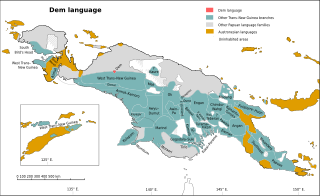| Dem | |
|---|---|
| Lem | |
| Region | Papua: Western highlands along Rouffaer River headwaters |
Native speakers | (1,000 cited 1987) [1] |
Trans–New Guinea
| |
| Language codes | |
| ISO 639-3 |
dem |
| Glottolog |
demm1245 |
| ELP | Dem |
 Map: The Dem language of New Guinea
The Dem language
Other Trans–New Guinea languages
Other Papuan languages
Austronesian languages
Uninhabited | |
Dem (Lem, Ndem) is a divergent Papuan language of West New Guinea. Although Palmer (2018) leaves it unclassified, [2] it was tentatively included in the Trans–New Guinea family in the classification of Malcolm Ross (2005), and Timothy Usher ties it most closely to Amung. [3]
The only pronouns which have been recorded are 1sg nau, 2sg aŋ, and 1pl yu.
Vocabulary
The following basic vocabulary words are from Voorhoeve (1975), [4] as cited in the Trans-New Guinea database: [5]
gloss Dem head yagabuak hair ari; yakuli eye eŋgio tooth yavkasa leg abuo louse nduu dog kwa pig uwam; uwom bird bela egg au; onde blood miet skin aran; asi tree niye man ŋo sun uweməja water da; yat fire kunu stone (da)ŋat name aluŋ; gago eat nenawe one yagaŋ two ugwaŋ
Further reading
- Word lists
- de Bruijn, J. V. 1941. Verslag van een Tocht naar Beura, het Stroomgebied van de Beurong en Lelop, het Stroomgebiet van de Ielorong in Centraal Nieuw Guinea door den Controleur der Wisselmeren van 9 Juni 1941 tot 7 Augustus 1941 [Report of a Survey Trip to Beura, the Beurong and Lelop Watersheds, the Ielorong Watershed in Central New Guinea by the Wissel Lakes Administrator the 9th of June. 1941 to the 7th of August 1941]. Nationaal Archief, Den Haag, Ministerie van Koloniën: Kantoor Bevolkingszaken Nieuw-Guinea te Hollandia: Rapportenarchief, 1950–1962, nummer toegang 2.10.25, inventarisnummer 256.
- Galis, Klaas Wilhelm. 1955. Talen en dialecten van Nederlands Nieuw-Guinea [Languages and dialects of Netherlands New Guinea]. Tijdschrift Nieuw-Guinea 16: 109–118, 134–145, 161–178.
- Larson, Gordon F. 1977. Reclassification of some Irian Jaya Highlands language families: A lexicostatistical cross-family subclassification with historical implications. Irian 6(2): 3–40.
- Le Roux, C. C. F. M. 1950. De Bergpapoea’s van Nieuw-Guinea en hun Woongebied [The Mountain Papuans of New Guinea and their Habitat], Vol 2. Leiden: E. J. Brill. (pages 852–862, 892–895)
- Voorhoeve, Clemens L. 1975. Languages of Irian Jaya, Checklist: Preliminary Classification, Language Maps, Wordlists. Canberra: Pacific Linguistics.
References
- ^ Dem at Ethnologue (18th ed., 2015) (subscription required)
- ^ Palmer, Bill (2018). "Language families of the New Guinea Area". In Palmer, Bill (ed.). The Languages and Linguistics of the New Guinea Area: A Comprehensive Guide. The World of Linguistics. Vol. 4. Berlin: De Gruyter Mouton. pp. 1–20. ISBN 978-3-11-028642-7.
- ^ NewGuineaWorld
- ^ Voorhoeve, C.L. Languages of Irian Jaya: Checklist. Preliminary classification, language maps, wordlists. B-31, iv + 133 pages. Pacific Linguistics, The Australian National University, 1975. doi: 10.15144/PL-B31
- ^ Greenhill, Simon (2016). "TransNewGuinea.org - database of the languages of New Guinea". Retrieved 2020-11-05.
- Ross, Malcolm (2005). "Pronouns as a preliminary diagnostic for grouping Papuan languages". In Andrew Pawley; Robert Attenborough; Robin Hide; Jack Golson (eds.). Papuan pasts: cultural, linguistic and biological histories of Papuan-speaking peoples. Canberra: Pacific Linguistics. pp. 15–66. ISBN 0858835622. OCLC 67292782.